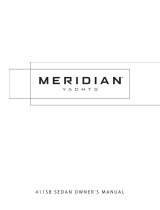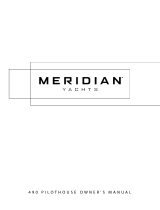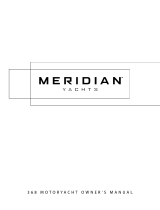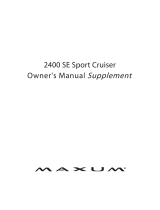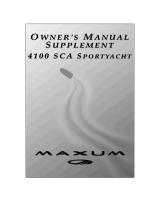Page is loading ...



Port Engine Serial Number: _________________________________________
Starboard Engine Serial Number: ____________________________________
Hull Identification Number:__________________________________________
Date of Purchase __________________________________________________
Hull Identification Number
•The Hull Identification Number (HIN) is located on the starboard side of the transom.
•Record the HIN (and the engine serial numbers) in the space provided above.
•Please refer to the HIN for any correspondence or orders.
© 2002 Meridian Technical Publications. All rights reserved.
No part of this publication may be reproduced, stored in any retrieval system, or transmitted in any form by any means, electronic, mechanical, photocopying,
recording or otherwise, without prior written permission of Meridian.
Printed in the United States of America.
General Notes
The material in this document is for information only and is subject to change without notice. While reasonable efforts have been made in the preparation of this
document to assure its accuracy, Meridian assumes no liability resulting from errors or omissions in this document, or from the use of information contained herein.
Due to our commitment to product improvement, Meridian reserves the right to make changes in the product design, specifications, and equipment at any time
without notice or obligation. Illustrations and/or photos may show optional equipment.
All Meridian products meet or exceed USCG (Unites States Coast Guard) and/or NMMA (National Marine Manufacturer’s Association) construction standards.
Manufactured with 1,1,1 Trichloroethane, a substance which harms public health and environment during the manufacturing process by destroying ozone in the
upper atmosphere.
Proprietary Rights
This document discloses subject matter in which Meridian has proprietary rights. The information and design disclosed herein were originated by and are the prop-
erty of Meridian. Neither receipt nor possession thereof confers or transfers any right to reproduce, copy, alter or disclose the document or any part thereof, any
information contained therein, or to construct boats or any item from it, except by written permission from or written agreement with Meridian. This document is
to be returned upon request to Meridian.

CONTENTS
1 Chapter 1: Welcome Aboard!
1 Dealer Service
1 About Your Express Limited
Transferable Warranty
1 Boating Experience
2 Engines & Accessories Guidelines
2 Engines & Accessories Literature
2 Safety Standards
3 Qualified Maintenance
3 Structural Limitations
4 Boat Lifting
5 Special Care For Moored Boats
5 Sacrificial Anodes (Zincs)
6 Carbon Monoxide (CO)
7 Sources of CO
7 Carbon Monoxide Alarm System
7 What To Do If Carbon Monoxide Is Detected
8 Chapter 2: Propulsion &
Related Systems
8Engine
8 Engine Cooling System
8 Exhaust System
9 Engine Room Ventilation System
10 Fuel System
10 Fuel Fills & Vents
10 Fuel Filters
11 Fuel Transfer Pump (If Equipped)
11 Anti-siphon Valves (If Equipped)
11 Oil Change System (If Equipped)
11 Fire Suppression System (If Equipped)
12 Shaft-Transmission Alignment
12 Shaft Log Packless Sealing System
12 Rudder Stuffing Gland
13 Chapter 3: Controls
13 Steering
13 Autopilot (If Equipped)
14 Docking On Command (D.O.C.) System
(If Equipped)
14 Shift/Throttle Controls
14 Trim Tabs
15 Chapter 4: Navigation &
Communication Equipment
15 VHF Radio (If Equipped)
15 Compass
15 Radar (If Equipped)
15 Depth Finder
16 Chapter 5: Plumbing
16 Bilge Pumps
16 Bilge Pump Testing
17 Autofloat Switches
18 Freshwater System
18 City Water Inlet
19 Water Heating Systems
19 Transom Shower (If Equipped)
20 Drain Systems
20 Deck Drains
20 Sink Drains
20 Shower Drain System
21 Seawater Systems
21 Seacocks
21 Seawater Strainers
22 Marine Head System
22 VacuFlush Head System (If Equipped)

23 Chapter 6: Deck Equipment
23 Cleats
23 Windlass (If Equipped)
24 Davit (If Equipped)
24 Canvas (If Equipped)
25 Chapter 7: Appliances & Entertainment
Systems
25 Audio & Visual Equipment
25 Dockside Television & Telephone Inlet
26 Propane System (If Equipped)
26 Propane Stove (If Equipped)
27 Electric Stove (If Equipped)
28 Chapter 8: Lights
28 Care and Maintenance
28 Interior & Exterior Lights
28 Spotlight (If Equipped)
29 Chapter 9: Heating & Air Conditioning
29 Air Conditioning System (If Equipped)
29 Electric Heaters (If Equipped)
29 Heat Exchanger Cabin Heater (If Equipped)
30 Chapter 10: Electrical System
31 12-Volt DC System
31 Batteries
31 Battery Switches
31 Fuses and Circuit Breakers
31 12-Volt Accessory Outlet(s)
32 Alternators
32 Battery Charger or Inverter/Charger
33 Alternating Current (AC) System
34 Shore Power
35 Connecting To Shore Power
35 Shore Power Cable Hoist (If Equipped)
35 Inverter Power (If Equipped)
36 Generator (If Equipped)
37 Starting Generator
38 Important Records
39 Float Plan

Hazard Boxes & Symbols
The hazard boxes and symbols shown below are used throughout this supplement to call attention to potentially dan-
gerous situations which could lead to either personal injury or product damage. Read ALL warnings carefully and
follow all safety instructions.
DANGER!
!
This box alerts you to immediate hazards which WILL cause severe personal injury or death if
the warning is ignored.
This box alerts you to hazards or unsafe practices which COULD result in severe personal
injury or death if the warning is ignored.
WARNING!
!
This box alerts you to hazards or unsafe practices which COULD result in minor personal
injury or cause product or property damage if the warning is ignored.
CAUTION!
!
NOTICE
This box calls attention to installation, operation or maintenance information, which is impor-
tant to proper operation but is not hazard related.
EXPLOSION
HAZARD!
NO OPEN
FLAME!
HOT
HAZARD!
ROTATING
PROPELLER HAZARD!
FALLING
HAZARD!
ELECTRICAL
HAZARD!
CO POISONING
HAZARD!
FIRE
HAZARD!
RUN BILGE BLOWERS
FOR 4 MINUTES!

1
Meridian Yachts • Owner’s Manual
Chapter 1: Welcome Aboard!
•This Owner’s Manual provides information about your yacht that is not covered in the Cruiser & Yacht Owner’s
Manual Supplement.
•Before using your yacht, study this Owner’s Manual, the Cruiser & Yacht Owner’s Manual Supplement, and all
engine and accessory literature carefully.
•Keep this Owner’s Manual and the Cruiser & Yacht Owner’s Manual Supplement on your yacht in a secure, yet
readily available place.
•When this owner’s manual went to press, wiring diagrams and systems views were not available. We apolo-
gize for any inconvenience this may cause. A Limited Edition, Captains Packet will be forwarded to you as
soon as these diagrams and views are completed.
Dealer Service
•Ask your dealer to explain all systems before taking delivery of your yacht.
•Your dealer is your key to service.
•Contact your dealer if you have any questions or problems with your new yacht.
•If your dealer cannot help, call our customer service hotline: 360-403-2198 or send us a FAX: 360-403-1158.
•Buy replacement parts from any authorized Meridian dealer.
About Your Express Limited Transferable Warranty
•Meridian offers an Express Limited Transferable Warranty on each new Meridian purchased through an autho-
rized Meridian dealer.
•A copy of the Express Limited Transferable Warranty was included in your owner’s packet.
•If you did not receive a copy of the Express Limited Transferable Warranty, please contact your dealer or
call 360-403-2198 for a copy.
Boating Experience
If this is your first yacht or if you are changing to a type of yacht you are not familiar with, obtain handling and oper-
ating experience before assuming command of the yacht.
Take one of the boating safety classes offered by the U.S. Power Squadrons or the U.S. Coast Guard Auxiliary. For
more course information, including dates and locations of upcoming classes, contact the organizations directly:
•U.S. Power Squadrons: 1-888-FOR-USPS (1-888-367-8777) or on the Internet at: http://www.usps.org
•U.S. Coast Guard Auxiliary: 1-800-368-5647 or on the Internet at: http://www.cgaux.org
Outside the United States, your selling dealer, national sailing federation or local boat club can advise you of local
sea schools or competent instructors.
CONTROL HAZARD! A qualified operator must be in control of the yacht at all times. DO NOT
operate your yacht while under the influence of alcohol or drugs.
WARNING!
!

CHAPTER 1: WELCOME ABOARD! Meridian Yachts • Owner’s Manual
2
Engines & Accessories Guidelines
•Your yacht’s engines and accessories were selected to provide optimum performance and service.
•Installing different engines or other accessories may cause unwanted handling characteristics.
•Should you choose to install different engines or to add accessories that will affect the yacht’s running trim, have
an experienced marine technician perform a safety inspection and handling test before operating your yacht again.
•Certain modifications to your yacht will result in the cancellation of your warranty protection. Always
check with your dealer before making any modifications to your yacht.
•The engines and accessories installed on your yacht come with their own operation and maintenance manuals.
Read and understand these manuals before using the engines and accessories.
Engine & Accessories Literature
•The engine and accessories installed on your boat come with their own operation and maintenance manuals.
•Read and understand these manuals before using the engine and accessories.
•Unless noted otherwise, all engine and accessory literature referred to in this Owner’s Manual is included in your
owner’s packet.
Safety Standards
Your yacht’s mechanical and electrical systems were designed to meet safety standards in effect at the time it was
built. Some of these standards were mandated by law, all of them were designed to insure your safety, and the safety
of other people, vessels and property.
In addition to this Owner’s Manual, please read the Cruiser & Yacht Owner’s Manual Supplement and all acces-
sory literature for important safety standards and hazard information.
NOTICE
When storing your yacht please refer to your engine’s operation and maintenance manuals.
DANGER
PERSONAL SAFETY HAZARD! DO NOT allow anyone to ride on parts of the
yacht not designated for such use. Sitting on seat backs, lounging on the forward
deck, bow riding, gunwale riding or occupying the transom platform while
underway is especially hazardous and will cause personal injury or death.
DANGER!
!
DANGER
PERSONAL SAFETY HAZARD! ALWAYS secure the anchor and other loose objects before get-
ting underway. The anchor and other items that are not properly secured can come loose when
the yacht is moving and cause personal injury or death.
DANGER!
!

Meridian Yachts • Owner’s Manual CHAPTER 1: WELCOME ABOARD!
3
Qualified Maintenance
•Failure to maintain your yacht’s systems (listed in the warning above) as designed could violate the laws in your
jurisdiction and could expose you and other people to the danger of bodily injury or accidental death.
•Follow the instructions provided in the Cruiser & Yacht Owner’s Manual Supplement, this Owner’s Manual, the
engine owner’s manual and all accessory literature.
Structural Limitations
The command bridge and the transom platform are designed to be lightweight for proper yacht balance. The load
limit for these platforms is 30 pounds per square foot, evenly distributed.
To maintain the integrity and safety of your yacht, allow only qualified personnel to perform
maintenance on, or in any way modify: The steering system, propulsion system, engine control
system, fuel system, environmental control system, electrical system or navigational system.
WARNING!
!

CHAPTER 1: WELCOME ABOARD! Meridian Yachts • Owner’s Manual
4
Boat Lifting
•Always follow the lift equipment’s instructions and requirements.
•Water in the bilge can shift and change the balance of the load.
•If water is present in the bilge, pump or drain the water out of the bilge areas before lifting your yacht.
•When lifting your yacht, always position the lifting slings at the port and starboard, lifting sling label positions.
PERSONAL INJURY and /or PRODUCT OR PROPERTY DAMAGE HAZARD!
•Lifting slings may slip on the hull.
•Avoid serious injury or death by securing the lifting slings together before lifting.
WARNING!
!
PERSONAL INJURY and /or PRODUCT OR PROPERTY DAMAGE HAZARD!
•NEVER lift the yacht using the bow and stern eyes.
WARNING!
!
PRODUCT or PROPERTY DAMAGE HAZARD!
•When lifting any yacht, always use a spreader bar. The spreader bar must be equal to the
width of the yacht at each lifting point.
CAUTION!
!

Meridian Yachts • Owner’s Manual CHAPTER 1: WELCOME ABOARD!
5
Special Care For Moored Boats
•Whether moored in saltwater or freshwater, your yacht will collect marine growth on its hull bottom.
•This will detract from the yacht’s beauty, greatly affect its performance and may damage the gelcoat.
•There are two methods of slowing marine growth:
1. Periodically haul the yacht out of the water and scrub the hull bottom with a bristle brush and a solution of soap
and water.
2. Occasionally re-paint the hull below the waterline with a good grade of anti-fouling paint.
Sacrificial Anodes (Zincs)
Your yacht features sacrificial anodes (zincs) to protect underwater metal parts from excessive deterioration. Check
the zincs regularly and replace them if they have deteriorated more than 70%.
There are many factors that affect the rate at which the zincs deteriorate, including:
•Water temperature
•Salinity
•Water pollution
Stray electrical current from the yacht or dock may cause complete deterioration in just a few weeks. If there is rapid
zinc deterioration, measure the electrolytic corrosion around your yacht with a corrosion test meter. If the zincs are
not bonded correctly, they will not provide protection.
NOTICE
•To help seal the hull bottom and reduce the possibility of gelcoat blistering on moored
yachts, apply an epoxy barrier coating, such as INTERLUX, Interprotect 2000E/2001E. The
barrier coating should be covered with several coats of anti-fouling paint.
•Many states regulate the chemical content of bottom paints in order to meet environmental
standards. Check with your local dealer about recommended bottom paints, and about the
laws in effect in your area.
Do not paint between the zinc and the metal surface it contacts and do not paint over the zincs.
NOTICE
NEW SACRIFICIAL ANODE DETERIORATED SACRIFICIAL ANODE

CHAPTER 1: WELCOME ABOARD! Meridian Yachts • Owner’s Manual
6
Carbon Monoxide (CO)
•CO poisoning causes a significant number of boating deaths each year.
•Called the "silent killer", CO is an extremely toxic, colorless, odorless and tasteless gas.
•Breathing CO blocks the ability of your blood to carry oxygen.
•The effects are cumulative, even low levels of exposure can result in injury or death.
Factors increasing the effects of CO poisoning include:
•Age
•Smokers or people exposed to high concentrations of cigarette smoke
•Consumption of alcohol
•Lung disorders
•Heart problems
•Pregnancy
DANGER
CARBON MONOXIDE POISONING HAZARD!
Carbon monoxide gas (CO) is colorless, odorless, and extremely dangerous. All
engines, generators, and fuel burning appliances produce CO as exhaust. Direct and
prolonged exposure to CO will cause BRAIN DAMAGE or DEATH.
Signs of CO poisoning include:
•Headache
•Nausea
•Dizziness
•Drowsiness
DANGER!
!

Meridian Yachts • Owner’s Manual CHAPTER 1: WELCOME ABOARD!
7
Sources of CO
Sources of CO include:
To correct stationary situations (a) and/or (b):
•Close all the windows, portlights and hatches.
•If possible, move your yacht away from the source of the CO.
To correct running situations (c) and/or (d):
•Trim the bow down.
•Open the windows and the canvas.
•When possible, run the yacht so that prevailing winds will help dissipate the exhaust.
Immediately take corrective action if the CO is detected (see, Carbon Monoxide Alarm System, below).
Carbon Monoxide Alarm System
•Your yacht features a carbon monoxide (CO) alarm system.
•Do not disconnect the alarm system.
•Read and understand the manufacturer’s instructions for your CO alarm system. If you did not receive an instruc-
tion manual, call (800) 383-0269 and one will be mailed to you.
•If your yacht is not equipped with a carbon monoxide alarm, consider purchasing one from your dealer or marine
supply store.
What To Do If Carbon Monoxide Is Detected
•Immediately ventilate and evacuate any enclosed spaces that are occupied by people and reset your CO alarm.
•Immediately move anyone showing any symptoms of CO poisoning into fresh air.
•See a doctor if any symptoms persist. If the person is unconscious, immediately administer oxygen or CPR and
call for emergency help.
c. Running yacht
with trim angle
of bow too high.
b. Mooring close to
another boat that
is using its engine,
generator or any
other CO source.
a. Using engine
or generator
when yacht is
moored in a
confined space.
d. Running yacht without
through ventilation
(station wagon effect).

8
Meridian Yachts • Owner’s Manual
Chapter 2: Propulsion & Related Systems
Engine
Read and understand the engine operation and maintenance manuals before using or working on the engines.
Engine Cooling System
The engine cooling system circulates raw water around components and also uses a freshwater heat exchanger on the
engine to reduce engine temperature.
•Make sure both engine seawater intake valves (seacocks) are open before starting the engines and keep the sea-
cocks open while the engines are running.
•The cooling system’s seawater strainers should be checked for leaks and debris every time you use your yacht. For
instructions on how to clean the seawater strainers, see the Seawater Systems section of this Owner’s Manual.
Exhaust System
•The exhaust system is designed to keep seawater out of the engines in most sea conditions.
•However, do not anchor the stern to sea or shut the engines off if high seas might flood the exhaust system.
•Always consider the sea conditions before anchoring or shutting off the engines.
SYSTEM DAMAGE HAZARD!
The engine cooling system’s seacocks must be opened before engines are started and during
engine operation.
CAUTION!
!
DANGER!
!
CARBON MONOXIDE POISONING HAZARD!
Leaking engine and/or generator exhaust is a source of dangerous carbon monoxide
gas (CO). Check all exhaust systems before each trip.
•Look for leaks in the exhaust systems of the propulsion engines and the generator.
•Look for discoloration, water leaks, carbon or stains around all joints.
•Make sure all of the exhaust clamps are in place and secured.
•Make sure the ventilation systems work and are not obstructed or restricted.
•To reduce the chance of CO entering the living spaces, fill any gaps around engine room
plumbing, cableways, exhaust systems, doors, hatches, and access panels.

Meridian Yachts • Owner’s Manual CHAPTER 2: PROPULSION & RELATED SYSTEMS
9
Engine Room Ventilation System
•The bilge blowers remove explosive fumes from the engine room.
•Fresh air is drawn into the engine room through the deck vents.
To make sure the engine room is properly ventilated:
•Always run the bilge blowers for at least four minutes before starting the engines or the generator (if equipped).
•Continue to run the blowers until your yacht has reached cruising speed.
•Always run the blowers when operating the yacht below cruising speed.
FIRE/EXPLOSION HAZARD
•Use of the blower system is NOT A GUARANTEE that explosive fumes have been removed.
•If you smell fuel, DO NOT start the engines or generator and DO NOT turn on any
electrical devices.
•If you smell fuel and the engines and/or generator are already running, SHUT OFF the
engines and/or generator and TURN OFF all electrical devices. Investigate immediately.
•DO NOT obstruct or modify the ventilation system.
WARNING!
!

CHAPTER 2: PROPULSION & RELATED SYSTEMS Meridian Yachts • Owner’s Manual
10
Fuel System
Carefully read the fuel section of both the Owner’s Manual and the engine operation manual, paying special attention
to the subject of fuel recommendations.
Fuel Fills & Vents
•The fuel fill fitting is marked “Diesel” or "Gas".
•The fuel tank vent is located below the fuel fill.
•If you have trouble filling a fuel tank, check to see that the fuel fill and vent lines are free of obstructions
and kinks.
Fuel Filters
•The fuel pickup tube (located inside the fuel tank) is equipped with a fine mesh screen filter.
•In addition, when supplied by the engine manufacturer, a fuel filter is installed on the engine.
•Periodically replace the fuel filters to make sure they remain clean and free of debris.
•Consult with your selling dealer or local marina concerning fuel additives that help to prevent fungus or other
buildup in your fuel tank.
FIRE, EXPLOSION AND OPEN FLAME HAZARD!
•It is very important that the fuel system be inspected thoroughly the first time it is filled and
at each subsequent filling.
•The fueling instructions in the Owner’s Manual and the fuel recommendations in the engine
operation manual must be followed.
WARNING!
!
•Air in the diesel supply system can stop an engine or severely restrict performance. If you
suspect air in the fuel lines, refer to your engine operation manual for detailed instructions
on how to bleed the system.
CAUTION!
!
CAUTION
Avoid the storage or handling of gear near the fuel lines, fittings and tank.
!

Meridian Yachts • Owner’s Manual CHAPTER 2: PROPULSION & RELATED SYSTEMS
11
Fuel Transfer Pump (If Equipped)
Your yacht may feature a fuel transfer pump which pumps fuel from one tank to another.
Anti-siphon Valves (If Equipped)
•Gas fuel systems are equipped with anti-siphon valves.
•The valves are located at the point where the fuel feed line attaches to the fuel tank.
•The valves are spring loaded and are opened by fuel pump vacuum.
•This valves will prevent fuel from siphoning from the tanks in the event of a fuel line rupture.
Oil Change System (If Equipped)
Your yacht may feature an oil change pump to simplify draining and filling engine and generator oil. See the oil
change system instructions for information on the use of this system.
Fire Suppression System (If Equipped)
Before using your boat for the first time, read and understand the fire suppression system’s instruction and mainte-
nance manual and follow all warnings.
Observe the following:
•The system will go off automatically whenever direct heat from a fire is detected in the engine compartment.
•The system can be set off manually by pulling the T-handle (labeled “FIRE”) at the helm.
•The system can only be set off once during a fire. After the system is discharged it must be refilled and refurbished
before it can be used again.
ENVIRONMENTAL HAZARD!
NEVER transfer fuel into a full (or nearly full) fuel tank. Fuel transferred into a full tank will
spill overboard through the tank venting system.
CAUTION!
!
NOTICE
•If an engine running problem is diagnosed as fuel starvation, check the anti-siphon valve.
•If the valve is stuck or clogged, change or replace it while the engine is shut down.
•NEVER run an engine with the anti-siphon valve removed, except in an emergency.

CHAPTER 2: PROPULSION & RELATED SYSTEMS Meridian Yachts • Owner’s Manual
12
Shaft-Transmission Alignment
Alignment between the engine transmission output shaft
and the propeller is very critical. The alignment has been
performed at the factory and was rechecked by the dealer
after the yacht had been in the water for 48 hours.
•An alignment inspection should be performed by a
marine mechanic as part of the routine maintenance
program after the initial 30 hours of operation, then
every 60 hours and whenever unusual noise or vibra-
tion is noticed.
•Shaft-transmission alignment should be performed by
a marine mechanic since it requires moving the
engine and prop shaft.
•To insure proper alignment after a haulout or dry stor-
age, wait 48 hours after launching before final align-
ment adjustments by a marine mechanic are made.
Shaft Log Packless Sealing System
The shaft log packless sealing system’s shaft seal is a maintenance-free, watertight seal that doesn’t require packing
or adjustments.
Rudder Stuffing Gland
•The rudder stuffing gland is part of the assembly where the
rudders emerge from the bottom of the yacht.
•The shaft stuffing gland should not leak any water.
•If a leak develops, it can usually be stopped by tightening
the packing gland nuts slightly. Do not over tighten the
packing gland nuts.
•If stuffing gland leakage becomes excessive, packing
replacement can be performed as follows:
1. Remove the yacht from the water.
2. Loosen the packing gland nuts and back the packing
gland from the sleeve.
3. Remove the old packing.
4. Wrap the new packing around the shaft.
5. Cut the rings with a razor blade at an angle approximately 30 degrees to the long axis of the shaft.
6. Stagger the ends of each ring around the shaft and insure that the rings are at the bottom in the sleeve.
7. Tighten the packing gland nuts until resistance is felt.
SYSTEM DAMAGE HAZARD!
•If you suspect a shaft-transmission misalignment, have a qualified mechanic perform an
alignment inspection as soon as possible.
•Continued use may lead to premature engine, transmission, shaft, shaft seal and/or
hull damage!
CAUTION!
!
TRANSMISSION-TO-PROP SHAFT COMPONENTS (TYPICAL)
SECTION VIEW
OF HULL
CLAMPS
CLAMPS
SHAFT LOG
(TRIANGLE FLANGE)
BELLOWS
SHAFT
ROTOR
FLANGE BOLTS
CARBON/GRAPHITE
FLANGE
COUPLER
TRANSMISSION
OUTPUT FLANGE
TILLER ARM
RUDDER STUFFING
GLAND (TYPICAL)
(TYPICAL)
UPPER RUDDER
BEARING SUPPORT
(TYPICAL)
VIEW OF TYPICAL RUDDER SYSTEM

13
Meridian Yachts • Owner’s Manual
Chapter 3: Controls
Steering
•This yacht features a power assisted rack-and-pinion steering system.
•Check the fluid level in the power steering reservoir every time you use your yacht.
•Yacht steering is not self-centering.
Autopilot (If Equipped)
The autopilot will aid you in maintaining the chosen course of your yacht.
•Never leave the helm while the autopilot system is on!
•A qualified operator must monitor the autopilot system at all times and keep lookout for
other marine traffic and other hazards.
WARNING!
!
NOTICE
•Τ
ΤΤ
Τhe autopilot system is only an aid to navigation.
•It's accuracy can be affected by many factors, including equipment failure or defects, envi-
ronmental conditions & improper handling or use.

CHAPTER 3: CONTROLS Meridian Yachts • Owner’s Manual
14
Docking On Command (D.O.C.) System (If Equipped)
•Your yacht may feature a D.O.C. system which can be controlled from either helm.
•The thruster(s) allow you to maneuver the yacht in close quarters when docking.
•Read the thruster’s operation manual before using the thruster(s) for the first time.
Shift/Throttle Controls
Read all of the information about the shift/throttle controls in the shift/throttle manual, the engine operation manual,
and the Cruiser & Yacht Owner’s Manual Supplement.
Trim Tabs
•The trim tabs may be used to help keep your yacht level at cruising speeds.
•The trim tabs are controlled by two rocker switches at the helm.
•Before using the trim tabs read and understand the trim tab operation manual.
Note the following:
•Once cruising speed is reached, the port or starboard trim switch may be used (one at a time) to level the yacht.
•Perform trim tab adjustment with several short touches to the switch rather than one long one.
•After each short touch allow several seconds for the hull to react.
•The trim tab hydraulic fluid reservoir is located in the engine compartment. The fluid level must be checked
periodically (at least once a year) and refilled as necessary.
LOSS OF CONTROL HAZARD!
Improper maintenance of shift/throttle hardware may cause a sudden loss of control!
WARNING!
!
LOSS OF CONTROL HAZARD!
Improper use of trim tabs will cause loss of control!
•Do not allow anyone unfamiliar with trim tabs to use them.
•Do not use trim tabs in a following sea as they will cause broaching or other unsafe
handling characteristics.
•Do not use trim tabs to compensate for excessive unequal weight distribution.
WARNING!
!
/
